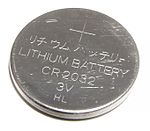

Lithium metal batteries are primary batteries that have metallic lithium as an anode. The name intentionally refers to the metal as to distinguish them from lithium-ion batteries, which use lithiated metal oxides as the cathode material.[1] Although most lithium metal batteries are non-rechargeable, rechargeable lithium metal batteries are also under development. Since 2007, Dangerous Goods Regulations differentiate between lithium metal batteries (UN 3090) and lithium-ion batteries (UN 3480).[2]
They stand apart from other batteries in their high charge density and high cost per unit. Depending on the design and chemical compounds used, lithium cells can produce voltages from 1.5 V (comparable to a zinc–carbon or alkaline battery) to about 3.7 V.
Disposable primary lithium batteries must be distinguished from secondary lithium-ion or a lithium-polymer,[3] which are rechargeable batteries and contain no metallic lithium. Lithium is especially useful, because its ions can be arranged to move between the anode and the cathode, using an intercalated lithium compound as the cathode material but without using lithium metal as the anode material. Pure lithium will instantly react with water, or even moisture in the air; the lithium in lithium-ion batteries is a less reactive compound.
Lithium batteries are widely used in portable consumer electronic devices. The term "lithium battery" refers to a family of different lithium-metal chemistries, comprising many types of cathodes and electrolytes but all with metallic lithium as the anode. The battery requires from 0.15 to 0.3 kg (5 to 10 oz) of lithium per kWh. As designed these primary systems use a charged cathode, that being an electro-active material with crystallographic vacancies that are filled gradually during discharge.

The most common type of lithium cell used in consumer applications uses metallic lithium as the anode and manganese dioxide as the cathode, with a salt of lithium dissolved in an organic solvent as the electrolyte.[4]
- ^ Mekonnen, Yemeserach; Sundararajan, Aditya; Sarwat, Arif I. (2016). "A Review of Cathode and Anode Materials" (PDF). Retrieved December 27, 2023.
- ^ Committee of Experts on the Transport of Dangerous Goods and on the Globally Harmonized System of Classification and Labelling of Chemicals, ed. (2006-12-14). "ST/SG/AC.10/34/Add.1 - Report of the Committee of Experts on its Third Session, Addendum, Annex 1, Amendments to the fourteenth revised edition of the Recommendations on the Transport of Dangerous Goods, Model Regulations" (PDF). Geneva: United Nations. Retrieved 2021-05-13.
- ^ Batscap - La batterie lithium métal polymère Archived 2012-08-08 at the Wayback Machine in batscap.com
- ^ "One Man and His Whippet". Eco Tree Lithium. Retrieved 2022-02-19.